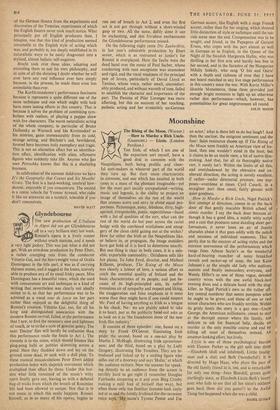Moonshine
The Rising of the Moon. (Warner.) —How to Murder a Rich Uncle. (Gaumont.) — Lizzie. (London Pavilion.) THE Irish, of which I am one of the expatriate sort myself, have a good deal in common with the Neapolitans, both being prolific and cheer- ful sum-makers in whatever part of the world they turn up. But their main chartcteristic in common, and one which has resulted in both case in a mass of the phoniest imaginable—yet for the most part locally unrepudiated—writing, music and legends, is the ability to project an image of themselves on the rest of the world that arouses scorn and envy in about equal pro- portions. Picturesque, noisy, bibulous, dirty, high- spirited, irresponsible, poetic, superstitious—faced with a list of qualities of the sort, what can the rest of the world do but peer across the racial hedge with the combined wistfulness and smug- gery of the clean child gazing out at the urchin? How far either the Irish or the Neapolitans like, or believe in, or propagate, the image outsiders have got hold of it is hard to determine exactly. But one thing is clear in both cases, it is a sale- able, exportable commodity : Oirishness sells like hot pizzas. To John Ford, director, and Michael Killanin, producer, The Rising of the Moon was clearly a labour of love, a serious effort to catch the essential quality of Ireland and the basic characteristics of its people; and just be- cause of its high-principled aim, its rather tremulous air of sympathy and respect and liking, the exaggeration and false emphasis in it seem worse than they might have if one could suspect Mr. Ford of having anything as Irish as a tongue in his cheek. No: we are plainly asked to take it to heart, just as the publicity hand-out asks us to look on it as 'the foundation stone of the new Irish film industry.'
It consists of three episodes: one, based on a story by Frank O'Connor, illustrating Irish pride; the second, based on a one-act play by Martin J. McHugh, illustrating Irish uproarious- ness; and the third, based on a play by Lady Gregory, illustrating The Troubles. They are in- troduced and linked up by a smiling figure who sidles out of a doorway and says 'Hullo,' at which the audience twitters. Now the manner for speak- ing directly to an audience from the screen is terribly hard to get right (I remember Douglas Fairbanks simpering at it and even Bing Crosby making a mild fool of himiself that way), but when those only too familiar features look coyly out at us and the faintly-Irishised-for-the-occasion voice says, 'My name's Tyrone Power and I'm an actor,' what is there left to do but laugh? And then the unction, the emigrant sentiment and the fuss! Sales resistance shoots up. If The Rising ol the Moon were frankly an American view of Ire- land, then one wouldn't mind in the least, but it claims to be an inside view, a bit of native film- making. And that, for all its thoroughly native cast, it surely isn't. Within the limits of all this, and overshadowed by the obtrusive and ex- uberant direction, the acting is mostly excellent, if rather—under directorial pressure, one sup- poses—overdone at times. Cyril Cusack, in a straighter part than usual, fairly gleams with quiet goodness.
How to Murder a Rich Uncle, Nigel Patrick's first attempt at direction, comes in at the back door of that gently macabre British school of comic murder. I say the back door because al- though it has a good idea, a mildly witty script and a cast that produces some dazzling short per- formances, it never loses an air of family charades about it that goes oddly with the polish and neatness of individual moments. This is partly due to the mixture of acting styles and the extreme unevenness of the performances which range from Athene Seyler's as the wonderful hard-of-hearing muncher of noisy breakfast cereals and sucker-up of soup, the late Katie Johnson's as the simple old lady who outlives, outwits and finally outmurders everyone, and Wendy Hiller's as one of those vague, devoted country wives with the one awful black-lace evening dress and a delicate hand with the slug- killer, to Nigel Patrick's own as the rather off- key central murderer that seems pompous when he ought to be grave, and those of one or two minor characters who are frankly terrible. Within its grisly limits the story is a gay one—Uncle George, the American millionaire, comes to staY at the decrepit manor where his family, too delicate to ask for financial help, decide ou murder as the only possible course and end bY killing off most of themselves instead. Au amateur-looking effort, but lively.
Lizzie is one of those psychological heavies with Eleanor Parker as the girl split into three —Elizabeth (dull and inhibited), Lizzie (malig. nant and a slut) and Beth ('wonderful'). It is directed by Hugo Haas, who plays the part of the old family friend in it, too, and is remarkable for only one thing—Joan Blondell, grown quite startlingly stout, as Elizabeth-Lizzie-Beth's boozY aunt who fails to see that all her niece's oddness goes back (how did you guess?) to the Awful Thing that happened when she was a child.
ISABEL QUIOLY


































 Previous page
Previous page